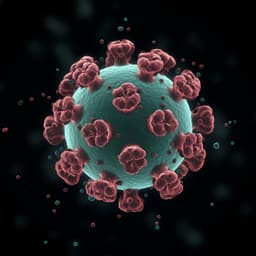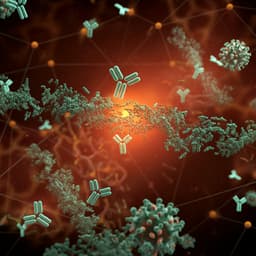
Medicine and Health
Characterising proteolysis during SARS-CoV-2 infection identifies viral cleavage sites and cellular targets with therapeutic potential
B. Meyer, J. Chiaravalli, et al.
This groundbreaking study by Bjoern Meyer and colleagues uncovers novel cleavage sites in SARS-CoV-2 proteins S and N using mass spectrometry. The research highlights potential therapeutic targets and demonstrates how targeting specific substrates inhibits SARS-CoV-2 replication. A must-listen for those interested in advancing COVID-19 research and treatments!
~3 min • Beginner • English
Introduction
The study investigates how proteolytic cleavage shapes SARS-CoV-2 infection biology. Coronaviruses rely on viral proteases (papain-like protease, PLP/nsp3, and main protease, Mpro/nsp5) to process viral polyproteins and can cleave host proteins to modulate cellular pathways. Cellular proteases (e.g., FURIN, TMPRSS2, cathepsins) also process viral proteins, notably spike, affecting entry route and antigenicity. Understanding in situ proteolysis during infection can refine vaccine antigen design and identify host pathways amenable to antiviral intervention. The authors aim to provide an unbiased map of proteolysis in infected cells, define novel cleavage sites in viral proteins (especially S and N), and identify host substrates of SARS-CoV-2 proteases with potential therapeutic value.
Literature Review
Prior work characterized SARS-CoV-2-host interactions via proteomics, phosphoproteomics, ubiquitinomics, interactomes, and proximity interactomes, identifying host pathways and potential drug targets. Viral proteases have been shown to cleave innate immunity regulators (e.g., IRF3, NLRP12, TAB1). Spike processing by FURIN, TMPRSS2, and cathepsins is known to influence entry, but precise cleavage sites for TMPRSS2/cathepsins are incompletely defined. Other coronavirus proteins undergo host-mediated processing (e.g., ORF7A signal peptide cleavage; caspase cleavage of N). Mass spectrometry N-terminomics offers unbiased detection of protease-generated neo-N-termini and precise cleavage sites but has been underused in coronavirus infection contexts.
Methodology
- Cell models and infection: Vero E6 (African green monkey kidney) and A549-Ace2 (human lung epithelial overexpressing ACE2) cells infected with SARS-CoV-2 (MOI 1) in biological triplicate. Timepoints: 0, 6, 12, 24 h; mock at 0 and 24 h. Viral RNA (qRT-PCR), protein abundance (TMTpro-based proteomics), and infectious titres (plaque assay) quantified over time.
- N-terminomics workflow: Adapted TMTpro-based N-terminomics to enrich blocked N-termini. After TMTpro labelling (blocking lysines and N-termini), trypsin digestion (ArgC-like specificity), undecanal labelling of free tryptic N-termini, depletion of undecanal-tagged peptides, and enrichment of native/neo-N-termini. LC-MS/MS on Q-Exactive-HF; MaxQuant for identification/quantification; stringent filtering (PEP ≤0.02, PIF ≥0.7); normalization and KNN imputation. Neo-N-termini defined as starting at residue ≥2 (including signal peptide, Met excision, or protease-generated).
- Protease inhibitor experiment: Infected Vero E6 cells treated at 12 h post-infection with camostat mesylate (TMPRSS2/trypsin inhibitor; control) or calpeptin (cathepsin/calpain inhibitor), harvested at 24 h; N-terminomics performed to assess inhibitor-sensitive cleavage events.
- Variant proximity analysis: Compared positions of identified viral neo-N-termini relative to characteristic mutations in VOC/VOIs (as of 24 May 2021) using covariants.org; Kolmogorov–Smirnov testing for enrichment.
- Pseudovirus assays: Lentiviral particles pseudotyped with WT or mutant SARS-CoV-2 spike (S13A, V635G, C671G, V635G/C671G, and RaTG13 lacking FURIN site) assessed for entry into HEK-ACE2 and HEK-ACE2-TMPRSS2 cells by flow cytometry. Western blot of pseudovirus to determine S1/S0 (cleaved/uncleaved) ratios.
- Host substrate discovery: Motif analysis (dagLogo) of enriched cellular neo-N-termini; identification of sequences matching/approximating Mpro [(A/P/S/T/V)xLQ] or PLP [LxGG] consensus near P4–P1 and showing increased abundance at 24 h. TopFIND used to link termini to causal proteases (where supported). GO enrichment with clusterProfiler.
- Validation of cleavage: In vitro LTE cell-free expression of GFP-tagged targets (PNN, PAICS, SRC) incubated with recombinant Mpro or PLP; detection by in-gel GFP fluorescence. Cell-based validation: expression of SARS-CoV-2 nsp4–nsp5 to generate active Mpro; western blot detection of endogenous PAICS and GOLGA3 cleavage (C-terminal antibodies).
- siRNA functional screen: A549-Ace2 cells transfected with dsiRNAs targeting 14 candidate substrates (and controls), infected at 24 h (MOI 0.1), harvested at 72 h; viral RNA (qRT-PCR) and titres (plaque assay) quantified; knockdown efficiency confirmed; viability assessed.
- Drug testing: Dose–response of inhibitors targeting candidate substrates (e.g., tyrosine kinase inhibitors including Bafetinib, Sorafenib; MYLK inhibitors ML-7 and MLCK inhibitor peptide 18) in A549-Ace2 cells pre- and post-infection; antiviral efficacy by viral RNA reduction; cytotoxicity by CellTiter-Glo; IC50/CC50 estimated in Matlab.
- Statistics: t-tests (Welch’s where appropriate), ANOVA with multiple testing correction (Storey q-values; Benjamini–Hochberg), KS tests, PCA; figures generated in R/Matlab. HIquant used to infer cleavage stoichiometry for a subset of substrates.
Key Findings
- Global proteolysis landscape:
- Identified >2700 TMTpro-labelled neo-N-termini per cell line; 497 shared between A549-Ace2 and Vero E6 with positive correlation (Pearson 0.64–0.70).
- Significant alterations in abundance of viral and cellular neo-N-termini at 24 h post-infection compared with mock, with viral N-termini increased as expected.
- Viral proteins:
- Spike (S): Novel neo-N-terminus at S637 detected in both cell lines, increasing over time (0–24 h). S637 lies on a flexible loop near the FURIN site; its abundance reduced by calpeptin and increased by camostat treatment in Vero E6.
- Additional spike neo-N-terminus at Q14 (pyroglutamate-modified) in Vero E6, consistent with signal peptide cleavage and prior observations in recombinant spikes.
- ORF3a: Multiple N-terminal processing sites (AA 10, 13, 16) consistent with signal peptide/processing and unstructured N-terminus in cryo-EM.
- Nucleocapsid (N): Extensive cleavage with shared neo-N-termini at residues 17, 19, 69, 71, 76, 78, 154, 263, indicating clustered processing and potential exoproteolysis.
- Other viral termini detected in M, ORF7a (signal peptide removal), ORF9b, and replicase polyprotein (e.g., termini consistent with Mpro cleavage at nsp10–12 and nsp15–16 junctions).
- Protease inhibitor sensitivity (Vero E6):
- After normalization to total viral protein, calpeptin significantly reduced neo-N-termini at N(19), S(260), and S(637); camostat increased S(260) and S(637) (t-test p<0.05), implying cathepsin/calpain contribution to these cleavages and altered proteolysis under serine protease inhibition.
- Spike mutant functional data:
- Pseudovirus entry: V635G and RaTG13 (lacking FURIN site) exhibited significantly increased entry in HEK-ACE2 (t-test p<0.01), while C671G showed significantly decreased entry (p<0.0001). Similar trends in HEK-ACE2-TMPRSS2, with some effects not reaching significance.
- Western blot of pseudovirus: V635G displayed increased S1/S0 ratio (~3:1 vs. WT ~1:1; p<0.05), indicating enhanced cleaved spike incorporation correlating with increased infectivity. C671G showed poor spike incorporation/processing, consistent with structural role of C671 (disulfide bond).
- Host substrates of viral proteases:
- Motif enrichment indicated significant overrepresentation of Mpro-like cleavage motifs among upregulated cellular neo-N-termini (KS p<0.001); PLP-like motif enrichment not significant.
- High-confidence candidate substrates (match/near-match to consensus and increased at 24 h) include: NUP107, PAICS, PNN, SRC, XRCC1 (A549-Ace2); GOLGA3, MYLK (Vero E6); and ATAD2, ATP5F1B, BST1, KAT7, KLHDC10, NUCKS1, WNK1.
- Temporal profiling showed most Mpro-like substrates peak at 24 h; some PLP-like substrates increased by 12 h (e.g., BST1).
- In vitro cleavage: PNN and PAICS cleaved by Mpro; SRC cleaved by PLP with dose dependence, yielding cleavage products consistent with neo-N-termini at F67 and V86.
- Cell-based validation: Expression of active Mpro (nsp4–5) induced cleavage of endogenous PAICS and GOLGA3.
- Functional relevance (siRNA screen in A549-Ace2):
- Efficient knockdown for targets; cell viability comparable to controls.
- 10/14 targets showed significant reductions in viral RNA (one-way ANOVA p≤0.01), typically 100–1000-fold median decreases vs. control.
- All 14 targets yielded significant reductions in infectious titres (p≤0.01); PAICS and GOLGA3 reduced titres ~10-fold despite no significant RNA drop.
- Depletion of antiviral IRF3 increased titres/RNA (~3-fold), while TAB1 depletion decreased replication, aligning with known roles.
- Pharmacological inhibition:
- Bafetinib (ABL/LYN inhibitor with off-target SRC inhibition): IC50 ~0.79 μM (95% CI 0.23–1.35 μM), with limited cytotoxicity below 3.3–10 μM.
- Sorafenib (positive control kinase inhibitor): low μM inhibition, consistent with prior reports.
- MYLK inhibitors: ML-7 reduced replication with IC50 ~1.7 μM (95% CI 1.51–1.80 μM), CC50 ~5 μM; MLCK inhibitor peptide 18 showed no inhibition.
- Other SRC-family TKIs (Bosutinib, Saracatinib, Dasatinib) showed apparent inhibition but high cytotoxicity in the assay limited interpretation.
- Variant proximity: No global enrichment of neo-N-termini near characteristic VOC/VOI mutations (KS p=0.146); however, several neo-N-termini lie within 5–10 residues of variant sites (e.g., S13/18/19/677; N12/80/205/377; ORF3a), indicating potential for variant-associated modulation of cleavage and antigenicity.
Discussion
This work provides the first unbiased, infection-context N-terminomics map of SARS-CoV-2 proteolysis across two cell lines. The discovery of multiple novel viral cleavage sites—particularly in spike (S637, Q14) and nucleocapsid—has implications for antigen structure, antigenicity, and entry mechanisms. The S637 neo-N-terminus’ sensitivity to calpeptin and functional interplay with other processing events suggests that cellular cathepsins/calpains modulate spike maturation and may compete with FURIN/TMPRSS2 processing in certain cellular contexts. The V635G spike mutant’s increased cleaved S1 incorporation and infectivity supports the notion that shifts in protease usage can tune entry efficiency.
On the host side, enrichment of Mpro-like cleavage motifs and validation of cleavage for PNN, PAICS, SRC, GOLGA3 indicate that viral proteases target diverse pathways (RNA processing/splicing, metabolism, Golgi/nuclear interfaces, and signaling kinases). Functional siRNA and pharmacological data show many of these substrates are pro-viral: their depletion or inhibition reduces viral RNA and titres, suggesting proteolysis may modulate, rather than abolish, their functions to favor replication. Inhibitors of SRC-family kinases and MYLK demonstrated dose-dependent antiviral effects, highlighting host-targeted therapeutic avenues that may complement direct-acting antivirals.
The findings inform vaccine/diagnostic considerations (neo-N-termini potentially altering epitope exposure and antibody recognition), enhance understanding of protease-dependent entry routes, and provide a catalog of cleavage events to guide future structure-function and therapeutic studies.
Conclusion
The study maps proteolytic cleavage events during SARS-CoV-2 infection, identifying numerous novel viral cleavage sites (notably in S and N) and 14 candidate cellular substrates of Mpro/PLP. Functional experiments demonstrate that many substrates support efficient viral replication, and pharmacological inhibition of SRC and MYLK pathways reduces SARS-CoV-2 titres at non-cytotoxic concentrations. These results underscore the importance of proteolysis in viral replication and host-pathogen interactions, offering targets for host-directed therapies and insights to optimize antigen design for vaccines and diagnostics. Future work should validate cleavage events and therapeutic effects in additional physiologically relevant models (e.g., Calu-3, airway organoids, in vivo), dissect the mechanistic outcomes of specific cleavages on protein function and localization, and expand N-terminomics with complementary proteases to enhance site coverage.
Limitations
- Mass spectrometry constraints: TMTpro labelling and ArgC-like specificity yield longer peptides; cleavage sites not generating peptides of suitable length (e.g., FURIN site in spike, multiple viral polyprotein junctions) were not detected. Using multiple proteases in parallel could improve coverage.
- Cell model scope: Findings derived from Vero E6 and A549-Ace2 cells; TMPRSS2 is low/absent in these lines, biasing toward cathepsin-dependent entry and proteolysis pathways. Results may differ in TMPRSS2-rich systems (e.g., Calu-3, airway organoids) or in vivo.
- Inhibitor assays: Antiviral testing primarily in A549-Ace2 cells; some kinase inhibitors showed cytostatic/cytotoxic effects complicating specificity assessment.
- Causal inference: While motif enrichment and validation support Mpro/PLP cleavage of host targets, not all candidate cleavages were validated; subcellular compartmentalization in infection versus lysate-based studies can yield differing substrates.
- Variant analysis: No global enrichment near VOC mutations; functional impact of proximity for individual sites requires experimental verification.
Related Publications
Explore these studies to deepen your understanding of the subject.







